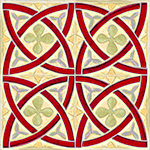Research

Original research in the visual arts
Research
This section outlines some of the principal research interests of my career to date. The nature of my work has often been interdisciplinary, mainly within the fields of art, history and religious studies, and the individual pages within this section are an attempt to isolate some of these individual strands.
Towards the end of my undergraduate studies in 1995 I developed an interest in creating parallel narratives in multimedia and began my first experiments with creating digital images from scanned drawings. These interests were expressed through my use of mythological and historical medieval Welsh texts, in particular two stories from the Welsh collection of stories known as the Mabinogion.
After graduating in Interactive Arts from Newport School of Art and Design in 1995, I sought to develop a more thorough understanding of early medieval Wales through an MA in Celto-Roman Studies at the University of Wales College, Newport. My MA thesis returned to Welsh medieval narrative tradition, and its interactions with oral tradition, written literature, material culture and the landscape, drawing on new developments in landscape archaeology.
One of the central concerns was the way in which the past is created through historical narratives, and the way in which visual traditions and motifs of the past have been revived and given new meanings was something that I developed while working on the ‘Visual Culture of Wales Project’ at the Centre for Advanced Welsh and Celtic Studies from 1999, as we considered the role of the past in shaping current and future identities. In particular, I researched the imaging of the medieval past and the revival of Celtic Christian styles of ornament, which were central elements of my visual practice.
The process of creating the CD-ROMs has also developed my understanding of the use of parallel and interacting approaches in the presentation of research. I took these ideas further once again while working on the visual culture of the Bible in Wales, writing and producing the DVD-ROM Imaging the Bible in Wales. As a large part of this current research included Gothic Revival artwork from churches, I developed my understanding of the reinvention of the medieval in nineteenth and twentieth-century Wales.
While working on ‘Imaging the Bible in Wales’, I became increasingly aware of the need and potential for studying stained glass, having accumulated a vast photographic archive of the medium in places of worship in Wales. I was then able to initiate the ‘Stained Glass in Wales’ project from 2009–11 at the Centre for Advanced Welsh and Celtic Studies in Aberystwyth. Drawing together the work undertaken on the ‘Imaging the Bible in Wales’ project with additional photography from my own archive, the new online ‘Stained Glass in Wales’ catalogue includes over 7,000 images of glass from the fourteenth century up to the present day. In June 2014 my history of stained glass from Welsh churches was published by Y Lolfa.
Since moving to Aberystwyth to work at the Centre for Advanced Welsh and Celtic Studies in 1999, I have tried to integrate my research interests into my work as an artist. I sought to consolidate this approach through doctoral research at the Centre, drawing together the themes of my visual work with an exploration of medievalism in the visual culture of Wales in the nineteenth and earlier twentieth century. I have also been developing a specialism in the field of decorative ecclesiastical art, particularly on stained glass in Wales.
I have been involved in new work on saints in Wales since joining the ‘Cult of Saints in Wales’ project in 2014, which continued as ‘Vitae Sanctorum Cambriae: The Latin Lives of the Welsh Saints'. This was followed by AHRC Follow-on funding, which led to the creation of a site detailing and mapping medieval saints cults in Wales, and a new website for researching the imagery of saints in Wales. Alongside these projects, I gave talks and published books and articles on the imagery of saints in Wales.
From 2019 to 2023 I worked on the 'Ports, Past and Present' project, which explored the tourist potential and cultural heritage of the port towns linking Wales and Ireland. I helped with curating a touring exhibition of work by ten artists and writers, and designed numerous books and publicity materials. A series of illustrated online articles relating to stained glass and journeys of the saints across the Irish Sea were prepared for the project, making use of these stories to develop tourist narratives.
In 2023–5 I worked on the stained glass archive at Swansea College of Art with Christian Ryan, recording and photographing hundreds of student panels collected by the college from the late 1950s. In 2025 I was successful in applying to the AHRC Catalyst scheme, and I am now working on a new project exploring the heritage and artistic significance of stained glass, alongside new fieldwork and cataloguing of windows. I am also contributing to another Catalyst project on the work of the fifteenth-century Welsh poet Gutun Owain.